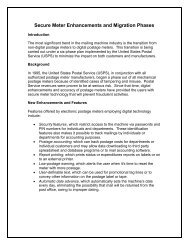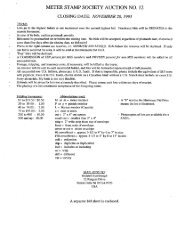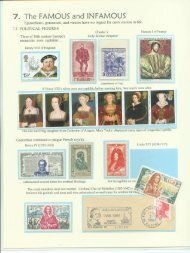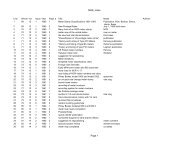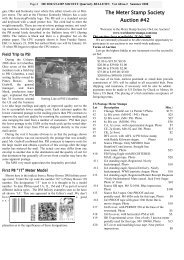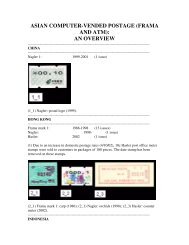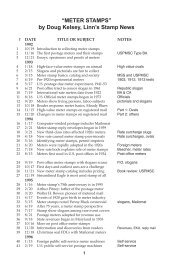GB Meter Franking - The Meter Stamp Society
GB Meter Franking - The Meter Stamp Society
GB Meter Franking - The Meter Stamp Society
You also want an ePaper? Increase the reach of your titles
YUMPU automatically turns print PDFs into web optimized ePapers that Google loves.
BRITISH STAMPS<br />
Fig 123 Group F frank from a Frankopost<br />
Multivalue machine Fig 124<br />
Emblems<br />
Following the change of adhesive stamp<br />
design coinciding with the new reign, the<br />
postal authorities noted comment in the<br />
press and elsewhere that it was time to<br />
consider changing the design of meter<br />
franks. A major criticism was that they<br />
resembled an adhesive stamp. It should be<br />
remembered that 30 years previously,<br />
when the design was introduced, the main<br />
reason for change was that the original<br />
design was insufficiently like that of an<br />
adhesive stamp! <strong>The</strong> Post Office asked the<br />
two manufacturers (UPF and Neopost) to<br />
propose a new design. <strong>The</strong>y, in turn,<br />
consulted the Council of Industrial Design,<br />
who nominated Stuart Rose, a well-known<br />
industrial artist.<br />
Stuart Rose prepared a design which was<br />
submitted to <strong>The</strong> Queen and approved by<br />
her.<br />
<strong>The</strong> new design embraced the floral<br />
emblems of the constituent parts of the<br />
United Kingdom; a rose for England, a<br />
thistle for Scotland, a daffodil for Wales<br />
and a shamrock for Northern Ireland.<br />
This design of frank—Group F—came<br />
into use in September 1959. Fig 123 shows<br />
the new frank fitted to a Frankopost Multivalue<br />
machine in use at Pitney Bowes’<br />
Birmingham office.<br />
<strong>The</strong> following machine models were in<br />
use when Group F franks were introduced<br />
and were fitted with the new franks. Group<br />
F franks were in use up to decimalisation<br />
and the prefixes used by these machines<br />
until that time were:<br />
Neopost LV N<br />
Pitney Bowes CV P, PA, PC<br />
Simplex Junior S, SA, SB<br />
Simplex Junior SV<br />
Mmachines<br />
Mconverted to<br />
MSimplex Major SV<br />
Simplex Major SX to SZ then<br />
backwards<br />
SW to SG<br />
omitting SI, SO,<br />
and SQ<br />
UPF Multivalue U, UA to UK<br />
omitting UI<br />
Neopost NA to NX<br />
MFrankmaster omitting NI<br />
Pitney Bowes A, AA to AH<br />
MAutomax<br />
Machines not fitted with Group F dies<br />
were: Pitney Bowes Model H; UPF Midget;<br />
Universal NZ and Pitney Bowes A, B and F.<br />
Specimens from<br />
Model CV<br />
machines before<br />
and after the<br />
merger of UPF<br />
with Pitney<br />
Bowes<br />
Fig 127 Frank from a four-bank Pitney<br />
Bowes 5000 Series machine<br />
Fig 126 <strong>The</strong> Neopost Model 205<br />
machine<br />
Fig 128 Hand-driven<br />
(above) and<br />
electrically-driven<br />
(right) 5000 Series<br />
machines<br />
Fig 125 (below)<br />
Specimen mark<br />
on perforated<br />
adhesive tape<br />
from the<br />
Neopost<br />
Model 205<br />
26 G.S.M. October 2001





